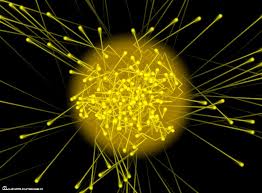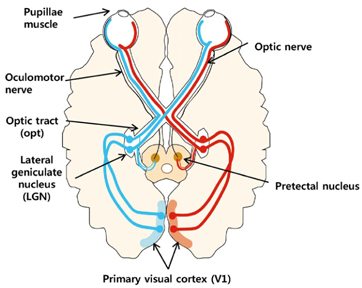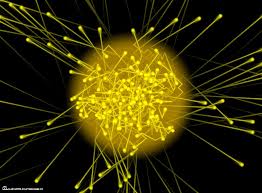I am currently enrolled in an independent study for Cognitive Science at my school (Westtown School).
Here is my recent post!
Vision is a prominent part of our sensations. A world that nobody can see will no doubt be chaotic. In fact, visions have been one of the most direct emotional drives in daily life. So how does Nature put everything together so that human beings can see?
Light
First, we can envision objects because there are “lights.” The general mechanism behind is that the starlight (including sunlight) is emitted and reflected by different objects on Earth. And lights, in general, are believed to consist of beads of photons that each contains energy. Such reflected light (beams of photons) is then captured by our eyes and processed by our brain to form images on our minds. The different wavelength of light will show different colors.

(A possible image of the Photons)
Eyes
Everyone knows that we see through our eyes. But eyes are complicated organs that are made up of different tissues and parts. Each of those biological segments is crucial for a satisfying visual experience like most of us have today.
The first tissues of our visual system that outside light touches are the cornea. The cornea is made of well-organized fibers and hence transparent. The rich transparent nerves that the cornea contains allow us to close our ours eyes. The transparency is critical here: it guarantees that the outside light can go through the cornea easily with few photons reflected or absorbed. Then, the photons go through a pool of transparent liquid called aqueous humor that biologically facilitates the maintenance for the cornea.
The next stop for the lights would be the pupil, a hole in the muscular structure called Iris. Through a simple stretching mechanism, Iris controls the amount of light that gets into our eyes. When the pupils are enlarged, more lights are allowed in and vice versa. An interesting implication is that people have their pupils enlarged when they face fear. That is because our brains naturally want more pieces of visual information (photons) in to obtain a better image of dangerous situations.
After Pupil, there is an ocean of vitreous humor (much larger volume compared to the aqueous humor) that takes up to 3/4 of the volume of our eyes. Those liquids are close to transparent, and their fibers function to refract the entered light accurately on the retina layer. Hopefully, through all the tissues, we could have the light focused at the retina. In fact, only half of the light begins at the cornea ends up at the retina. The lost lights are usually dissipated through refraction or absorbed by impurities.
Last but not least, the retina ” ‘tells the brain about aspects of light that are related to objects in the world’ ” (Wolfe 28-29). Not until the light reaches the retina would such light turns into the image we see considering all the lost photons on its way.

(Eye structure)
Images are crazily dense information-wise, and hence we have developed cells that can work on different segments of the pieces. Those cells are called the photoreceptors.
There are two critical photoreceptors on the retina layer that play crucial roles in processing the photons in the first place: the Rods and the Cones, both consist of segments (outer and inner segments that are responsible for filtering specific wavelengths of absorbed lights) and terminals that transmit visual information to the brain via different neurotransmitters. So in a way, the photoreceptors work as bridges between our eyes and our minds.
Fun fact: rods work better at night and cones work better during the day. Most nocturnal animals have developed robust rods network on their retinas.
The major vision processor of the brain is the primary visual cortex (V1), sometimes referred to the striate cortex. It locates at the back of the brain: that is why damaging the back our heads might cause serious issues with visions. At V1, more complicated structures will start to process and develop the orientation of visual information since the image we see are naturally opposite of what are real (our left eyes see the objects on the right, and our right eyes see the objects on the left). Then, there are detectors at V1 that handle edges and stripes of the forming image, working in a reception-stimulus mechanism.

(Pathways to V1)
In a sense, there are different types of visual information that each of those little cells are waiting for. Once they find what they want, they will shout it out to the brain and forms the image collaboratively. For instance, a cell is waiting (responsible) for chairs; it would remain silent when we see no chair, and once we see some chairs, the cells will become active and deliver the signal to the brain. What they usually process, however, are lines and black dots due to their limited size; so it may require thousands of those cells to recognize a chair as each of them recognize a dot or a line segment.
There are more intriguing details about our vision pathways in our brain. If you want to learn more about that (how those visual information gets to V1), I have found a great video that could help you visualize the pathways.
Beauty is one of the significant incentives for us to have visions. I have found a great Ted talk on this topic, and here is a leak of what I would elaborate on my next post: how your brain decides what is beautiful
References
Bermúdez, J. L. (2014). Cognitive science: An introduction to the science of the mind (2nd ed.). Cambridge: Cambridge University Press.
The eye – Blue Cone Monochromacy [Image]. (n.d.). Retrieved from https://www.google.com/url?sa=i&source=images&cd=&cad=rja&uact=8&ved=2ahUKEwjbpda_uL7gAhViT98KHTg4DdUQjRx6BAgBEAU&url=http%3A%2F%2Fwww.blueconemonochromacy.org%2Fhow-the-eye-functions%2F&psig=AOvVaw3GNq-UM4IxFyQmYBZIZmNG&ust=1550344232038868
The eye – Blue Cone Monochromacy [Image]. (n.d.). Retrieved from https://www.google.com/url?sa=i&source=images&cd=&cad=rja&uact=8&ved=2ahUKEwjbpda_uL7gAhViT98KHTg4DdUQjRx6BAgBEAU&url=http%3A%2F%2Fwww.blueconemonochromacy.org%2Fhow-the-eye-functions%2F&psig=AOvVaw3GNq-UM4IxFyQmYBZIZmNG&ust=1550344232038868
JFC. (n.d.). What exactly is a photon? Definition, properties, facts [Image]. Retrieved from https://www.google.com/imgres?imgurl=https%3A%2F%2Fcdn.zmescience.com%2Fwp-content%2Fuploads%2F2017%2F06%2Ffbdabet.jpg&imgrefurl=https%3A%2F%2Fwww.zmescience.com%2Fscience%2Fwhat-is-photon-definition-04322%2F&docid=hdKZ04sOqT4_MM&tbnid=zYI17xFv9EAcQM%3A&vet=10ahUKEwjC-7G0ub7gAhVGPN8KHRL3DAYQMwhpKAAwAA..i&w=780&h=575&bih=662&biw=1440&q=photons&ved=0ahUKEwjC7G0ub7gAhVGPN8KHRL3DAYQMwhpKAAwAA&iact=mrc&uact=8
KoreaMed Synapse [Image]. (n.d.). Retrieved from https://www.google.com/url?sa=i&source=images&cd=&cad=rja&uact=8&ved=2ahUKEwiH0L7Kvb7gAhVCPN8KHQ4RDCoQjRx6BAgBEAU&url=https%3A%2F%2Fsynapse.koreamed.org%2FViewImage.php%3FType%3DF%26aid%3D50902%26id%3DF1%26afn%3D161_NRP_11_5_381%26fn%3Dnrp-11-381-g001_0161NRP&psig=AOvVaw0uJOVXqMzVcL6IN3LLEOm&ust=155034559548288
Wolfe, J. M. (2006). Sensation & perception. Sunderland, Mass.: Sinauer Associates.

Hey Andy!
I am a psychology professor of University of Southern Carolina. Your blog is quite interesting and I want to discuss a research intern possibility with you.
I tried your email but seems that doesn’t work. Can you reply me with an updated contact?
Greetings
Randenv Powell
LikeLike
Dear Prof. Powell,
Glad you like my contents! I am flattered and would love to learn more about the intern opportunity. Feel free to contact me through temple0226@yahoo.com anytime.
Best Regards,
Andy
LikeLike